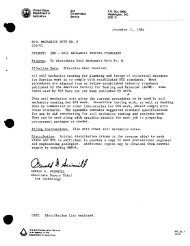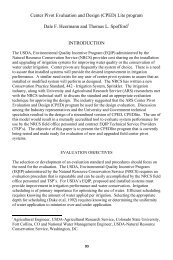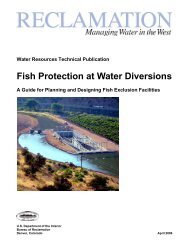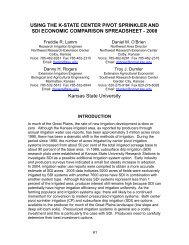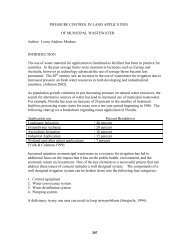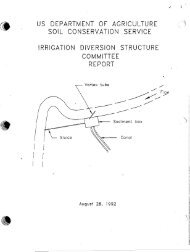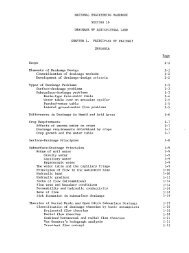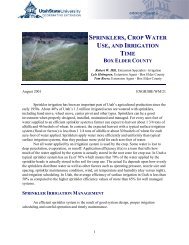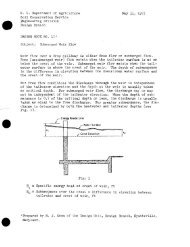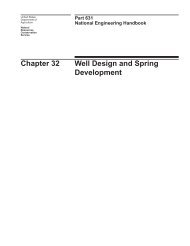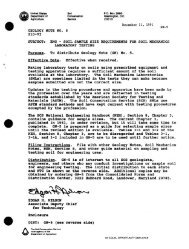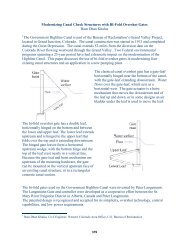Chapter 11: Sprinkle Irrigation - NRCS Irrigation ToolBox Home Page
Chapter 11: Sprinkle Irrigation - NRCS Irrigation ToolBox Home Page
Chapter 11: Sprinkle Irrigation - NRCS Irrigation ToolBox Home Page
You also want an ePaper? Increase the reach of your titles
YUMPU automatically turns print PDFs into web optimized ePapers that Google loves.
Hand-move lateral lines need to be limited to one<br />
or two pipe sizes for simplicity of operation. The<br />
trend in recent years has been toward the use of a<br />
single pipe size.<br />
Lateral lines should be located at right angles to<br />
the prevailing wind direction where possible and<br />
moved in the direction of the wind if the water contains<br />
more than 1000 ppm of salts.<br />
If lateral pipelines are to remain in a single design<br />
area and are not to be moved from field to<br />
field, they should be located so that they can be rotated<br />
around the mainline, thereby minimizing the<br />
hauling of pipe back to the starting point for subse.<br />
quent irrigations (see fig. <strong>11</strong>-29Ch<br />
Farming operations and row directions often influence<br />
the layout of laterals. Contoured row crops<br />
can be sprinkle irrigated only with hand-move or<br />
solid-set systems, which presents special problems<br />
such as difficulty in placing and moving lateral<br />
lines and getting uniform coverage.<br />
Where the land is terraced and the topography<br />
broken, curves in the alignment of the rows may be<br />
sharper than can be turned with the limited deflection<br />
angle of the coupling devices on portable irrigation<br />
pipe. This difficulty may be overcome in the<br />
following ways: soil profiles permitting, land grading<br />
may be used to improve terrace and row alignment;<br />
short lengths of flexible hose may be used in<br />
the line at the sharpest bends. Some growers prefer<br />
to run the laterals parallel and downhill on a slope<br />
somewhat steeper than the grade of the terraces<br />
even though both rows and terraces must be<br />
crossed by the pipelines. In such cases, several<br />
plants are removed or left out of each row at points<br />
crossed by the lateral lines.<br />
Where sloping land is terraced and the slopes are<br />
not uniform, lateral lines laid between crop rows<br />
will not be parallel, Thus the lateral spacing (s)<br />
will be variable between two adjacent lines. This<br />
variation adversely affects uniform application and<br />
efficient water use. Where topography permits their<br />
use, parallel terraces will help overcome this problem.<br />
Stripcropping has been used effectively in overcoming<br />
some of the difficulties arising from sprinkle<br />
irrigation of contoured row crops. The row crops<br />
are planted in strips equal in width to the lateral<br />
spacing. The alternating strips are equal in width to<br />
the lateral spacing at the mainline point of beginning<br />
but may vary considerably in width at points<br />
distant from the mainline. Laterals are laid on the<br />
contour along the outside of the row-crop strips as<br />
shown in figure <strong>11</strong>-31A. In this method the hay<br />
crops as well as khe row crop are irrigated. Advantages<br />
of this procedure are uniform coverage on the<br />
row-crop strips and the relative e6se of moving the<br />
pipe on firmer footing and outside the areas of tall<br />
crops, Disadvantages are nonuniform coverage on<br />
the secondary hay crop and the necessity for carefully<br />
laying out the strips before planting each crop.<br />
r --'I2<br />
SPACING Sm FROM EDGE OF STRIP<br />
. . MEADOW STRIP -<br />
--.>EL 3 -<br />
.___ --Z<br />
---<br />
MEADOW STRIP - N~<br />
_---- 1.- _---<br />
Figure 1l-31.-Typical<br />
areas.<br />
B<br />
sprinkler lateral layouts on stripcropped<br />
When it is not desired to irrigate the hay crop,<br />
part-circle sprinklers may be used to irrigate the<br />
row crop alone or the row crop may be planted in<br />
strips equal in width to some multiple of S, and<br />
the laterals operated entirely within the row-crop<br />
strips as shown in figure <strong>11</strong>-31B. A disadvantage<br />
is in having to move the pipe when the upper part<br />
of the soil is saturated.<br />
Perforated pipe laterals may be used when irrigating<br />
low-growing crops such as small vegetables. In



